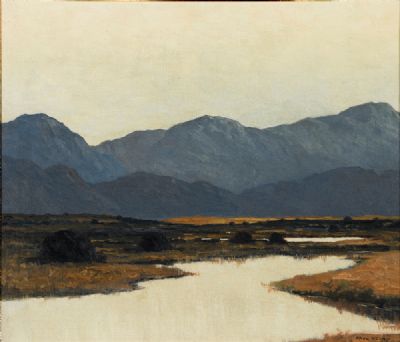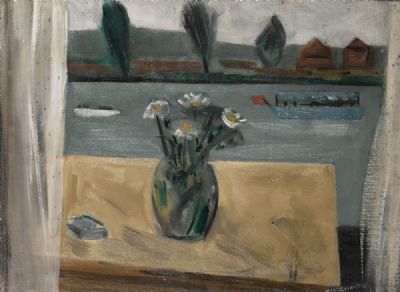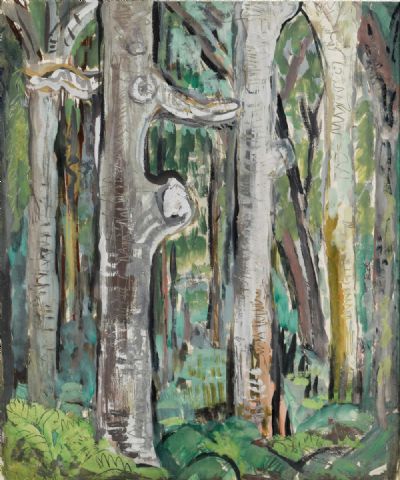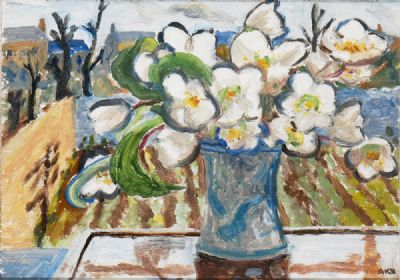Bidding on this item has ended.
Jack Butler Yeats
THE GAIETY THEATRE, DUBLIN (ROMEO & JULIET - THE LAST ACT) (1927)
Lot 58
Price Realised:
€195,000
Estimate:
€100,000 - €150,000
Jack B. Yeats RHA, 1871-1957
THE GAIETY THEATRE, DUBLIN (ROMEO & JULIET - THE LAST ACT) (1927)
Oil on canvas, 18" x 24" (51 x 76cm), signed, inscribed (twice) verso
Exhibited: 1927 Dublin (23); 1927 Birmingham (31); 1928 London (34); 1969 Montre... Read more
 Lot 58
Jack Butler Yeats
THE GAIETY THEATRE, DUBLIN (ROMEO & JULIET - THE LAST ACT) (1927)
Lot 58
Jack Butler Yeats
THE GAIETY THEATRE, DUBLIN (ROMEO & JULIET - THE LAST ACT) (1927)
THE GAIETY THEATRE, DUBLIN (ROMEO & JULIET - THE LAST ACT) (1927)
Oil on canvas, 18" x 24" (51 x 76cm), signed, inscribed (twice) verso
Exhibited: 1927 Dublin (23); 1927 Birmingham (31); 1928 London (34); 1969 Montre... Read more
 Lot 58
Jack Butler Yeats
THE GAIETY THEATRE, DUBLIN (ROMEO & JULIET - THE LAST ACT) (1927)
Lot 58
Jack Butler Yeats
THE GAIETY THEATRE, DUBLIN (ROMEO & JULIET - THE LAST ACT) (1927)
Estimate:
€100,000 - €150,000
Jack B. Yeats RHA, 1871-1957
THE GAIETY THEATRE, DUBLIN (ROMEO & JULIET - THE LAST ACT) (1927)
Oil on canvas, 18" x 24" (51 x 76cm), signed, inscribed (twice) verso
Exhibited: 1927 Dublin (23); 1927 Birmingham (31); 1928 London (34); 1969 Montreal (7); 1971 London (7) (col. repro); 1971-2 Dublin New York (62) (col. repro)
Provenance: Mrs Roger Frankland; purchased at Sotheby's (London) 14 July 1965 by Waddington Galleries, London; Private Collection, USA; John Rous, 4th Earl of Stradbroke, thence by descent; Bonhams, 1/7/20 (no.12) (Catalogue entry by Roisin Kennedy below)
Literature: Hilary Pyle, 'Jack B. Yeats, A Catalogue Raisonne of the Oil Paintings, Vol II', No 335, p.322, (1992, London).
**All bidding conducted through www.deveres.ie. Detailed condition report and additional images available on request**
According to Hilary Pyle, the artwork was originally 'sketched by the artist in sketchbook 215 [139]. The shadowed stage is predominantly blue, with the detail drawn in a darker blue, and other colours, describing the tomb, the candles and the prostrate figures in the centre of the stage. The dark heads of the audience are seen below, and in the stage boxes, against the dark gold frame of the stage.'
As Pyle states, Yeats painted stage scenes throughout his career in both watercolour and oil. With this depiction of Romeo & Juliet, Yeats 'achieves an atmosphere of romantic fantasy' through vertical, pale blue brushstrokes which 'lend to the stillness of the tableau'.
Charles Guonod's opera Romeo and Juliet was performed in the Gaiety Theatre in Dublin on 2 March 1926. Yeats was in attendance at the Gaiety and outlined the scene depicted in the painting in his sketchbook. He was an avid theatre goer and playwright and wrote several plays for children in the early 1900s. His later experimental plays Harlequin's Positions, La La Noo and In Sand were staged at the Abbey Theatre between 1939 and 1949.
Several of Yeats's paintings are inspired by his experiences of the theatre. These include Singing The Minstrel Boy (1923, The Model, Sligo), Now (1941, Private Collection), The Talent (1944, Private Collection) and Man Hearing an Old Song, (1950, Private Collection). These paintings like, Romeo and Juliet, incorporate the audience and its involvement in the performance.
Yeats's cursory sketch notes the two candles, the balcony to the right and the prominent form of the conductor which are all key elements in the final painting. The figure of the conductor can be seen in the painting on the extreme left. His head is erect and his arms extended as he conducts the concluding notes of Guonod's score.
The stage is framed by the warm reds and yellows of the surrounding auditorium. The heads of the front row of the audience fill the bottom of the composition. On the right hand side the towering structure of the interior of the Gaiety throws the perspective of the stage into stark relief. The elaborate gilt and maroon decoration is richly conveyed by loose swirls of deep colour which take on an organic quality, suggestive of movement and warm reflected light. A spectator is shown seated in the darkened theatre box looking at the performance. The ledge of this box, which stands out in sharp relief, is modelled out of thick brown paint while black lines indicate the railings. This unusual perspective emphasises the collaborative nature of live theatre in which the performers, musicians, and the spectators share in the illusion of the drama. It also draws attention to the artificiality of the set and the theatre itself as an extraordinary site where the human imagination is enabled to take flight.
THE GAIETY THEATRE, DUBLIN (ROMEO & JULIET - THE LAST ACT) (1927)
Oil on canvas, 18" x 24" (51 x 76cm), signed, inscribed (twice) verso
Exhibited: 1927 Dublin (23); 1927 Birmingham (31); 1928 London (34); 1969 Montreal (7); 1971 London (7) (col. repro); 1971-2 Dublin New York (62) (col. repro)
Provenance: Mrs Roger Frankland; purchased at Sotheby's (London) 14 July 1965 by Waddington Galleries, London; Private Collection, USA; John Rous, 4th Earl of Stradbroke, thence by descent; Bonhams, 1/7/20 (no.12) (Catalogue entry by Roisin Kennedy below)
Literature: Hilary Pyle, 'Jack B. Yeats, A Catalogue Raisonne of the Oil Paintings, Vol II', No 335, p.322, (1992, London).
**All bidding conducted through www.deveres.ie. Detailed condition report and additional images available on request**
According to Hilary Pyle, the artwork was originally 'sketched by the artist in sketchbook 215 [139]. The shadowed stage is predominantly blue, with the detail drawn in a darker blue, and other colours, describing the tomb, the candles and the prostrate figures in the centre of the stage. The dark heads of the audience are seen below, and in the stage boxes, against the dark gold frame of the stage.'
As Pyle states, Yeats painted stage scenes throughout his career in both watercolour and oil. With this depiction of Romeo & Juliet, Yeats 'achieves an atmosphere of romantic fantasy' through vertical, pale blue brushstrokes which 'lend to the stillness of the tableau'.
Charles Guonod's opera Romeo and Juliet was performed in the Gaiety Theatre in Dublin on 2 March 1926. Yeats was in attendance at the Gaiety and outlined the scene depicted in the painting in his sketchbook. He was an avid theatre goer and playwright and wrote several plays for children in the early 1900s. His later experimental plays Harlequin's Positions, La La Noo and In Sand were staged at the Abbey Theatre between 1939 and 1949.
Several of Yeats's paintings are inspired by his experiences of the theatre. These include Singing The Minstrel Boy (1923, The Model, Sligo), Now (1941, Private Collection), The Talent (1944, Private Collection) and Man Hearing an Old Song, (1950, Private Collection). These paintings like, Romeo and Juliet, incorporate the audience and its involvement in the performance.
Yeats's cursory sketch notes the two candles, the balcony to the right and the prominent form of the conductor which are all key elements in the final painting. The figure of the conductor can be seen in the painting on the extreme left. His head is erect and his arms extended as he conducts the concluding notes of Guonod's score.
The stage is framed by the warm reds and yellows of the surrounding auditorium. The heads of the front row of the audience fill the bottom of the composition. On the right hand side the towering structure of the interior of the Gaiety throws the perspective of the stage into stark relief. The elaborate gilt and maroon decoration is richly conveyed by loose swirls of deep colour which take on an organic quality, suggestive of movement and warm reflected light. A spectator is shown seated in the darkened theatre box looking at the performance. The ledge of this box, which stands out in sharp relief, is modelled out of thick brown paint while black lines indicate the railings. This unusual perspective emphasises the collaborative nature of live theatre in which the performers, musicians, and the spectators share in the illusion of the drama. It also draws attention to the artificiality of the set and the theatre itself as an extraordinary site where the human imagination is enabled to take flight.
- Enquire
- View all lots by this artist
- How bidding works
Please note: You will require a deVeres account in order to bid. Please register via the website. Each lot will close numerically. If there is late bidding the time may be extended which could delay subsequent lots. The lots will start to close from 2.00pm on auction day, closing at 45 second intervals.
PLEASE BID EARLY TO AVOID DISAPPOINTMENT.
In order to allow rival bidders the opportunity to respond to a late bid the following extensions will apply:
IF A BID IS RECEIVED WITHIN THE FINAL 45 SECONDS OF THE COUNTDOWN THE CLOCK WILL RESET TO 60 SECONDS.
At any point you can leave a maximum bid, representing the highest price you are prepared to pay for a particular lot. Bidding only advances when there is competition from a rival bidder. In that case the system bids on your behalf, only up to the maximum if required. All bids are relayed to you be email, along with notification if you have been outbid.
All maximum bids are confidential and not disclosed. The system will endeavor to purchase the lot for you for the least price. Bids are subject to buyer’s premium of 25% (incl vat), with no additional charges.
In the event of a tied bid, the preference will be given to the bid submitted first. The second bidder will receive immediate notification of being outbid.
PLEASE BID EARLY TO AVOID DISAPPOINTMENT.
In order to allow rival bidders the opportunity to respond to a late bid the following extensions will apply:
IF A BID IS RECEIVED WITHIN THE FINAL 45 SECONDS OF THE COUNTDOWN THE CLOCK WILL RESET TO 60 SECONDS.
At any point you can leave a maximum bid, representing the highest price you are prepared to pay for a particular lot. Bidding only advances when there is competition from a rival bidder. In that case the system bids on your behalf, only up to the maximum if required. All bids are relayed to you be email, along with notification if you have been outbid.
All maximum bids are confidential and not disclosed. The system will endeavor to purchase the lot for you for the least price. Bids are subject to buyer’s premium of 25% (incl vat), with no additional charges.
In the event of a tied bid, the preference will be given to the bid submitted first. The second bidder will receive immediate notification of being outbid.
Sign-up to our auction alert
Signup for personalised Irish art recommendations, invitations to viewings and auctions, articles and more.





 View More Videos
View More Videos DVTV Click Here To View Video
DVTV Click Here To View Video


